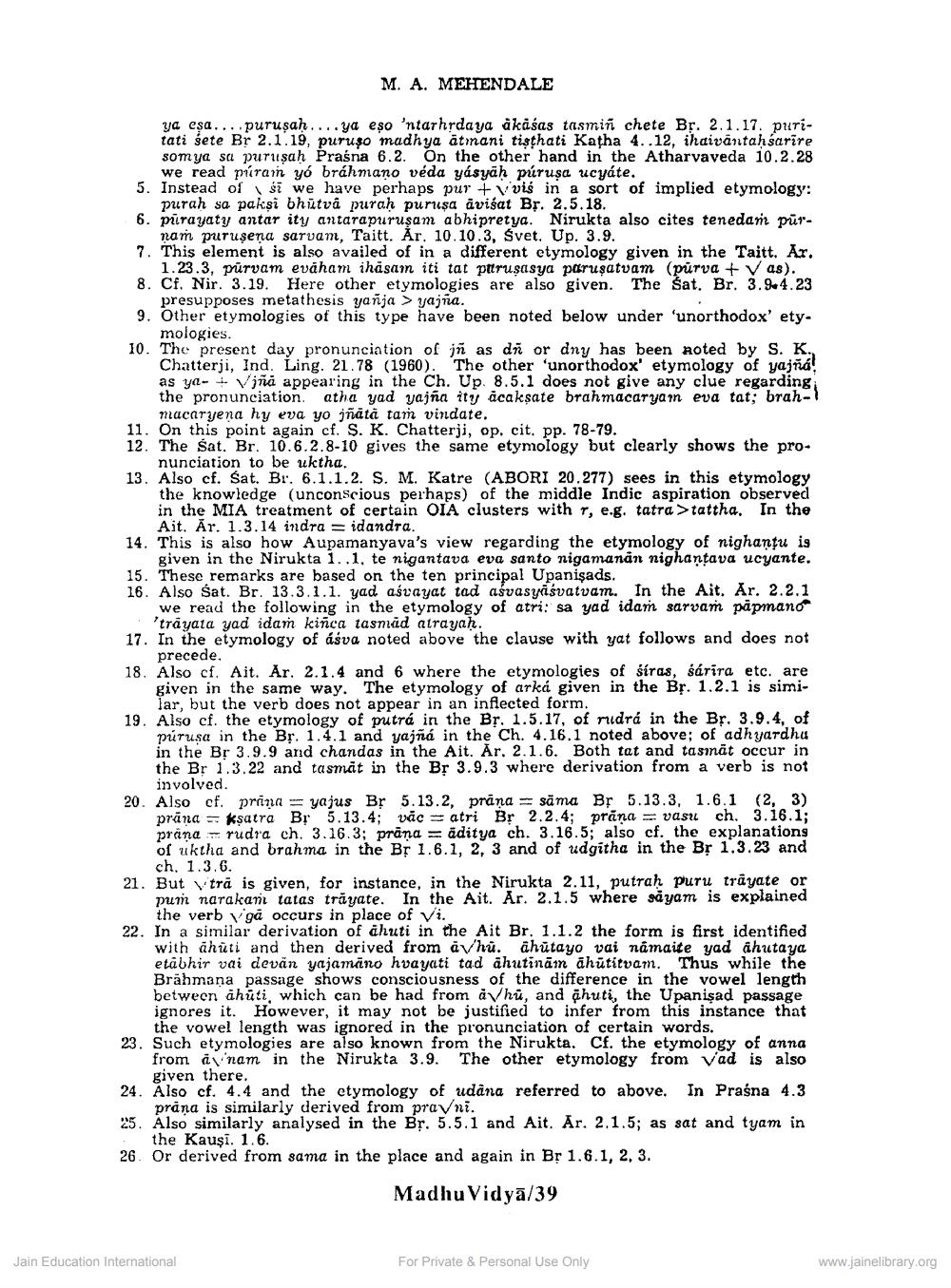________________
M. A. MEHENDALE
Diva
ya esa....purusah.... ya eso 'ntarhrdaya akaśas tasmin chete Br. 2.1.17. puritati sete Br 2.1.19, puruso madhya atrani tisthati Katha 4..12, ihaivāntahsarire somya sa purusah Praśna 6.2. On the other hand in the Atharvaveda 10.2.28
we read piiran yó bráhmano véda yásyāḥ pirusa ucyáte. 5. Instead of si we have perhaps pur + vois in a sort of implied etymology:
purah sa paksi bhūtvå purah purusa avisat Br. 2.5.18. 6. prayaty antar ity antarapuruşam abhipretya. Nirukta also cites tenedan pūr
nam purusena sarvam, Taitt. Ar. 10.10.3, Svet. Up. 3.9. 7. This element is also availed of in a different etymology given in the Taitt. Ar.
1.23.3, pūrvam eváham ihåsam iti tat pttruşasya paruşatvam (purva + Vas). 8. Cf. Nir. 3.19. Here other etymologies are also given. The sat. Br. 3.9.4.23
presupposes metathesis yanja > yajña. 9. Other etymologies of this type have been noted below under 'unorthodox' ety
mologies. 10. The present day pronunciation of jñ as dñ or dny has been noted by S. K.
Chatterji, Ind. Ling. 21.78 (1960). The other 'unorthodox' etymology of yajñá! as ya- + Viña appearing in the Ch. Up. 8.5.1 does not give any clue regarding the pronunciation. atha yad yajña ity acaksate brahmacaryam eva tat; brah-1
macaryena hy eva yo jñātā tam vindate. 11. On this point again cf. S. K. Chatterji, op. cit. pp. 78-79. 12. The sat. Br. 10.6.2.8-10 gives the same etymology but clearly shows the pro.
nunciation to be uktha. 13. Also cf. Sat. Br. 6.1.1.2. S. M. Katre (ABORI 20.277) sees in this etymology
the knowledge (unconscious perhaps) of the middle Indic aspiration observed in the MIA treatment of certain OIA clusters with T, e.g. tatra >tattha. In the
Ait. Ar. 1.3.14 indra = idandra. 14. This is also how Aupamanyava's view regarding the etymology of nighantu is
given in the Nirukta 1..1. te nigantava eva santo nigamanan nighantava ucyante. 15. These remarks are based on the ten principal Upanişads. 16. Also sat. Br. 13.3.1.1. yad aśvayat tad asvasyiśvatvam. In the Ait. Ar. 2.2.1
we read the following in the etymology of atri: sa yad idan sarvan päpmano
'trāyata yad idam kiñca tasmad atrayah. 17. In the etymology of ásva noted above the clause with yat follows and does not
precede, 18. Also cf. Ait. Ar. 2.1.4 and 6 where the etymologies of śiras, sárira etc. are
given in the same way. The etymology of arká given in the Br. 1.2.1 is simi
lar, but the verb does not appear in an inflected form. 19. Also cf. the etymology of putrá in the Br. 1.5.17, of midrá in the Br. 3.9.4, of
púrusa in the Br. 1.4.1 and yajñá in the Ch. 4.16.1 noted above; of adhyardha in the Br 3.9.9 and chandas in the Ait. Ar. 2.1.6. Both tat and tasmät occur in the Br 1.3.22 and tasmat in the Br 3.9.3 where derivation from a verb is not
involved. . Also cf. prana == yajus Br 5.13.2, prana = säma Br 5.13.3, 1.6.1 (2, 3)
prāna = ksatra Br 5.13.4; vāc =atri Br 2.2.4; prāna = vasul ch. 3.16.1; prana - rudra ch. 3.16.3; prana =āditya ch. 3.16.5; also cf. the explanations of uktha and brahma in the Br 1.6.1, 2, 3 and of udgitha in the Br 1.3.23 and
ch. 1.3.6. 21. But vtra is given, for instance, in the Nirukta 2.11, putrah puru trāyate or
pum narakan tatas trāyate. In the Ait. Ar. 2.1.5 where sayam is explained
the verb vga occurs in place of vi. 22. In a similar derivation of ahuti in the Ait Br. 1.1.2 the form is first identified
with āhuti and then derived from avhu. ahutayo vai namaite yad ahutaya etabhir vai devan yajamāno hvayati tad ahutinām āhūtitvam. Thus while the Brahmana passage shows consciousness of the difference in the vowel length between ahūti, which can be had from a hú, and ahuti, the Upanişad passage ignores it. However, it may not be justified to infer from this instance that the vowel length was ignored in the pronunciation of certain words. Such etymologies are also known from the Nirukta. Cf. the etymology of anna from anam in the Nirukta 3.9. The other etymology from Vad is also
given there. 24. Also cf. 4.4 and the etymology of udana referred to above. In Praśna 4.3
prana is similarly derived from pravni. 25. Also similarly analysed in the Br. 5.5.1 and Ait. Ar. 2.1.5; as sat and tyam in
the Kausi. 1.6. 26. Or derived from sama in the place and again in Br 1.6.1, 2, 3.
Madhu Vidyā/39
Jain Education International
For Private & Personal Use Only
www.jainelibrary.org




